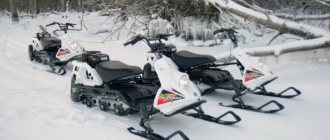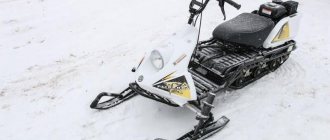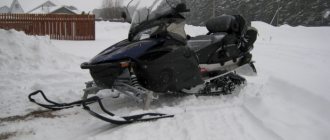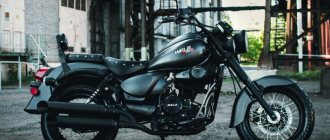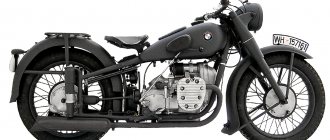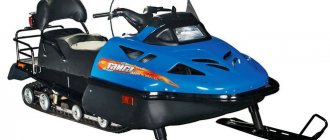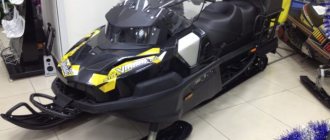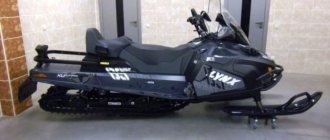Winter fishing is a special type of recreation, captivating with its extreme sports and the opportunity to have a good time. In order to get to the fishing spot, the most suitable transport is a snowmobile. Operating such a device does not require obtaining a driving license, and its price is quite affordable. One type of such vehicle is the Rybinka snowmobile. Easy to use, it allows you to easily navigate long distances in the snow.
Description
This device is also called a motorized towing vehicle or a transformer.
A motorized towing vehicle - because it can tow a trailer weighing up to 150 kg, with its own weight of 110 kg.
Transformer - because it can be disassembled into eight separate parts:
- motor with motor frame;
- steering column;
- electric starter;
- two skis with steering linkage;
- footrest;
- track suspension;
- side frame;
- circuit protection.
Each part weighs no more than 40 kg. It is easy to disassemble and transport in the trunk of a car to the place where the off-road begins. Collect within 5-8 minutes and then move off-road to the fishing spot.
Another advantage would be the use of a four-stroke gasoline engine. American single-cylinder Kohler units with a capacity of 7 horsepower. They work perfectly at sub-zero temperatures down to -35°C. Air cooled, started with an electric starter. Can be started using a manual starter.
The transmission is a variator with a chain drive and an automatic centrifugal clutch. Fuel supply is carburetor. Contactless ignition. To facilitate maintenance outside the garage, plastic covers can be easily removed to provide access to all units and components. The metal frame is coated using modern powder technology. This is effective protection against corrosion.
Reliable suspension – telescopic for two skis in front. Balancer-roller for the engine and skis at the rear.
The track is 38 centimeters wide and has an increased support area allowing it to move through snowy, moderate off-road conditions. On bare ice or compacted snow, a snowmobile can travel for a long time at speeds of up to 45 kilometers per hour.
An ergonomic seat has been designed for ease of movement. The driver can operate the device while sitting, standing, half-sitting or leaning on the seat with his knee. There is a large storage compartment under the seat. Even more things can be transported on a trailer. The mechanism is designed to transport a ski trailer or sled weighing up to 150 kg.
Another fact that speaks in favor of “Rybinka” is that the small-scale mechanization device does not require registration and obtaining permission from the management of a snowmobile or “motorized dog”.
Equipment
Optionally, the Rybinka snowmobile is equipped with a windshield, a battery, a bag for storing keys, and a heated handlebar function. The towbar to which the sled is mounted, as well as the electric starter, are included in the main configuration.
Weight and overall dimensions
Overall dimensions: length without skis - 1950, width with skis - 910, height with glass - 850. Device weight 110 kg.
Engine
The snowmobile is powered by a four-stroke single-cylinder Kohler engine model CH270-0115 with a power of 7 hp. s, volume 208 cm3. What does this give?
Advantages:
- Optimal fuel consumption and oil savings (consumption of pure gasoline, no need to limit yourself to creating a fuel mixture).
- Long service life of a four-stroke engine. The lubricating oil is separated from the combustion chamber.
- Eco-friendly.
- No additional equipment with domestic spare parts is required; the motor is tuned at the manufacturer.
- The engine is not very noisy and makes a normal sound during operation.
The power unit is located at the stern. Access to the motor is simple and convenient. Lubrication is carried out separately.
Cooling system
The cooling system of the Rybinka mini-snowmobile is air type. To ensure proper operation of an air-cooled power unit, periodic inspection of the quality of the impeller blades and fan is required.
Maximum speed
According to the stated parameters, the device reaches a speed of 20 km/h. But in reality, the power of the American Kohler four-stroke engine is enough to drive on a frozen body of water, as well as on a compacted roadway with a snow thickness of 45 cm when driving at speeds of up to 25 km/h.
Self-assembly
When disassembled, the structure takes up little space. Assembly before use is simple and intuitive. Anyone can do it, but you need to read the operating instructions carefully. In addition to assembly instructions and technical specifications, it contains advice on conducting technical inspections and observing safety precautions.
The assembly sequence is as follows:
- remove parts from the transport container;
- install the bracket between the ski and the king pin and secure it with an M8 x85 bolt;
- fix the steering rods in the ball joints;
- install the caterpillar mover and traverse on the frame;
- install the guard and footrests on the frame with a caterpillar drive;
- secure the seat in the frame with two clamps and a stopper;
- secure the steering wheel in the steering column with a stopper;
- add fuel and oil according to the instructions;
- adjust track tension;
- check the operation of the mechanisms.
Price
Prices for snowmobiles fluctuate depending on what model you are buying - new or used, in what city you plan to buy a snowmobile, whether sellers offer any promotions, organize sales, etc. Sometimes the price also includes delivery services, but often you have to pay for this separately.
Average price for a Rybinka mini snowmobile in big cities of the Russian Federation:
- St. Petersburg - from 85 thousand rubles;
- Kazan - 60,000-85,000 rubles;
- Moscow - from 100 thousand rubles;
- Saratov - from 60,000-80,000 rubles.
Of course, the cost of a used device from the Rybinka model range will be lower. Many stores are ready to offer favorable terms of credit and installment plans.
Maintenance
Like any other unit equipped with a gasoline engine and electrical equipment, a motorized snowmobile requires timely maintenance.
The instructions for the unit state that there are several types of maintenance:
- Daily maintenance of the EO;
- Maintenance after running in;
- TO-1;
- TO-2;
- CO.
Daily Maintenance
EO – daily maintenance. Carried out daily before use.
Includes:
- Check the operation of the gas lever (throttle valve drive) for smooth operation. When released, the lever should return to its original position on its own.
- Checking the brake mechanism. The brake should fully engage and return to place when the brake lever is released.
- Checking the condition of the caterpillar. An external inspection is done and the tension is checked.
- Checking the serviceability of the steering.
- The fuel and oil levels are determined.
- An external inspection of the casings is carried out, the tightening of the bolts, the availability of tools and spare parts are checked.
- Inspection of the towing device.
- Check the operation of the emergency stop, the serviceability of electrical equipment.
After use, the unit is thoroughly cleaned of dirt and ice, all places where water has accumulated are wiped off, and inspected for any malfunctions. All detected defects are eliminated.
Maintenance after break-in
After the break-in (check after the engine has operated for 5 engine hours), maintenance is performed similar to TO-1.
Maintenance TO-1
Maintenance service TO-1 is carried out after the engine has been running for 20 hours.
It includes:
- Checking the starting system (manual start), condition of the starting cord.
- Inspection of the exhaust gas system;
- Checking the condition of the engine cooling system.
- Checking the fuel system. If necessary, eliminate leaks.
- Change of oil.
- Checking the variator mounting.
- Adjusting the brake mechanism.
- Checking the functionality of the transmission chain tensioner.
- Inspection of skis, checking wear of skis and runners.
- Checking electrical equipment:
- checking and adjusting the spark plug gap;
- wiring condition monitoring;
- adjusting and checking the serviceability of the headlight.
11. General inspection of the snowmobile.
Maintenance TO-2
TO-2 is carried out after 50 hours of driving. Includes all operations performed during TO-1 and additional operations:
Checking the front suspension and steering.
Check and adjust, if necessary, the geometric parameters of the steering.
Seasonal service
Held at the end of the season. TO-1, TO-2 are performed. In addition, the apparatus is preserved for preservation in the summer.
To do this, lubricate the rubbing parts according to the diagram in the table of the operating instructions. All parts are first cleaned of old grease and dirt. Then processing is carried out. To do this, use the lubricants specified in the instructions.
How to remove play in the steering wheel?
To do this, you will need to put the steering wheel straight, holding the ends of the skis and moving them towards each other. Measure the distance between the ski axles. After this, carry out the calculation: ab=c. Should be from 0 to 15 mm.
If there is a deviation, then loosen the nuts fixing the main rod with the steering wheel tips on both sides, open the hood, take the long rod with your hand and turn it in a certain direction (if it doesn’t turn with your finger, then there are risks for the key in the place of the muffler). Skis should not converge or diverge.
History of development
Since 2013, when the first Rybinka was released, the snowmobile has had a four-stroke Japanese Subaru EX21 engine and a Canadian CVTech variator. The device developed power from 5 to 7 horsepower. The suspension was roller with spring. The mechanism had problems starting at low temperatures. Therefore, they began installing the American KohlerCH270 engine in Rybinka-2. The engine also developed a power of 7 hp. With. The variator was replaced with a box with a centrifugal dry clutch made in China. The spring was removed from the suspension.
Such savings significantly reduced the cost of the device. The engine “hit the mark,” but after replacing the variator with a clutch, big problems appeared on all snowmobiles due to the clutch. It could not withstand the loads and broke down on the first or second trip.
The Canadian CVT was returned to the released third and fourth generations of Rybinka. Added some design changes:
- installed running boards that improved the snowmobile's handling;
- modified fastening elements;
- Design errors have been corrected.
The result of “Rybinka-4” shows a good price/quality ratio for the snowmobile.
User manual
In order to maintain the Rybinka snowmobile in good condition and remove the causes that accelerate the wear of elements and assembly units, you will need to carry out all maintenance requests.
Maintenance is a preventative measure. It is important to carry out all work for any type of maintenance. They are carried out at certain intervals, regardless of the quality of the small-scale mechanization equipment.
Daniila Rukin
Snowmobile specialist "Buran". I go fishing in my free time.
Ask a Question
Reviews
Owners of the Rybinka snowmobile note the following advantages:
- high-torque engine;
- good dynamics;
- efficiency and maneuverability;
- it is very easy to disassemble in ten minutes and folds into the trunk of a car;
- The device moves on snow and ice, it does not skid if you do not overdo it with speed.
The device easily copes with the main task - it accelerates quickly and brakes effectively. The snowmobile can be repaired without any problems, just like a designer kit, and is quickly assembled and disassembled. These advantages are enough to purchase this device.
Among the negative qualities: the machine is intended only for 1 person - the driver, and at the same time it can be cramped in the snowmobile.
The main disadvantage is the engine, which takes time to heat up and continue to move. For a single-cylinder engine, the heating system is still weak. The service is not satisfactory, but if you need to repair the transmission, you will have to completely disassemble the device.


